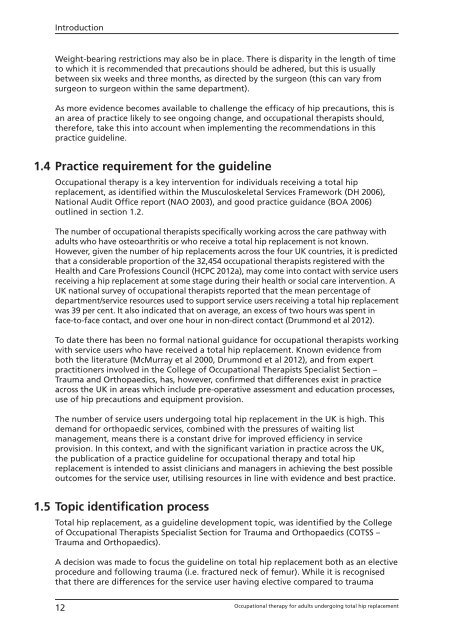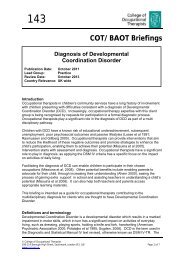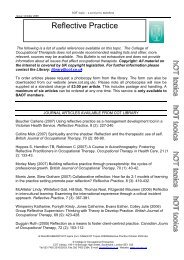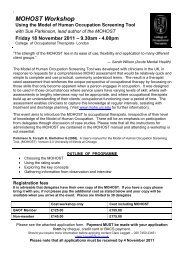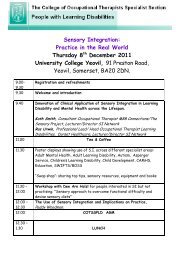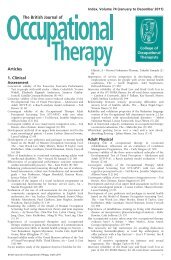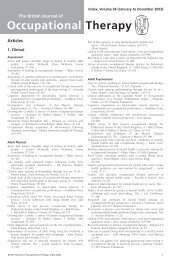Total hip replacement - College of Occupational Therapists
Total hip replacement - College of Occupational Therapists
Total hip replacement - College of Occupational Therapists
You also want an ePaper? Increase the reach of your titles
YUMPU automatically turns print PDFs into web optimized ePapers that Google loves.
Introduction<br />
Weight- bearing restrictions may also be in place. There is disparity in the length <strong>of</strong> time<br />
to which it is recommended that precautions should be adhered, but this is usually<br />
between six weeks and three months, as directed by the surgeon (this can vary from<br />
surgeon to surgeon within the same department).<br />
As more evidence becomes available to challenge the efficacy <strong>of</strong> <strong>hip</strong> precautions, this is<br />
an area <strong>of</strong> practice likely to see ongoing change, and occupational therapists should,<br />
therefore, take this into account when implementing the recommendations in this<br />
practice guideline.<br />
1.4 Practice requirement for the guideline<br />
<strong>Occupational</strong> therapy is a key intervention for individuals receiving a total <strong>hip</strong><br />
<strong>replacement</strong>, as identified within the Musculoskeletal Services Framework (DH 2006),<br />
National Audit Office report (NAO 2003), and good practice guidance (BOA 2006)<br />
outlined in section 1.2.<br />
The number <strong>of</strong> occupational therapists specifically working across the care pathway with<br />
adults who have osteoarthritis or who receive a total <strong>hip</strong> <strong>replacement</strong> is not known.<br />
However, given the number <strong>of</strong> <strong>hip</strong> <strong>replacement</strong>s across the four UK countries, it is predicted<br />
that a considerable proportion <strong>of</strong> the 32,454 occupational therapists registered with the<br />
Health and Care Pr<strong>of</strong>essions Council (HCPC 2012a), may come into contact with service users<br />
receiving a <strong>hip</strong> <strong>replacement</strong> at some stage during their health or social care intervention. A<br />
UK national survey <strong>of</strong> occupational therapists reported that the mean percentage <strong>of</strong><br />
department/service resources used to support service users receiving a total <strong>hip</strong> <strong>replacement</strong><br />
was 39 per cent. It also indicated that on average, an excess <strong>of</strong> two hours was spent in<br />
face- to- face contact, and over one hour in non- direct contact (Drummond et al 2012).<br />
To date there has been no formal national guidance for occupational therapists working<br />
with service users who have received a total <strong>hip</strong> <strong>replacement</strong>. Known evidence from<br />
both the literature (McMurray et al 2000, Drummond et al 2012), and from expert<br />
practitioners involved in the <strong>College</strong> <strong>of</strong> <strong>Occupational</strong> <strong>Therapists</strong> Specialist Section –<br />
Trauma and Orthopaedics, has, however, confirmed that differences exist in practice<br />
across the UK in areas which include pre- operative assessment and education processes,<br />
use <strong>of</strong> <strong>hip</strong> precautions and equipment provision.<br />
The number <strong>of</strong> service users undergoing total <strong>hip</strong> <strong>replacement</strong> in the UK is high. This<br />
demand for orthopaedic services, combined with the pressures <strong>of</strong> waiting list<br />
management, means there is a constant drive for improved efficiency in service<br />
provision. In this context, and with the significant variation in practice across the UK,<br />
the publication <strong>of</strong> a practice guideline for occupational therapy and total <strong>hip</strong><br />
<strong>replacement</strong> is intended to assist clinicians and managers in achieving the best possible<br />
outcomes for the service user, utilising resources in line with evidence and best practice.<br />
1.5 Topic identification process<br />
<strong>Total</strong> <strong>hip</strong> <strong>replacement</strong>, as a guideline development topic, was identified by the <strong>College</strong><br />
<strong>of</strong> <strong>Occupational</strong> <strong>Therapists</strong> Specialist Section for Trauma and Orthopaedics (COTSS –<br />
Trauma and Orthopaedics).<br />
A decision was made to focus the guideline on total <strong>hip</strong> <strong>replacement</strong> both as an elective<br />
procedure and following trauma (i.e. fractured neck <strong>of</strong> femur). While it is recognised<br />
that there are differences for the service user having elective compared to trauma<br />
12<br />
<strong>Occupational</strong> therapy for adults undergoing total <strong>hip</strong> <strong>replacement</strong>


